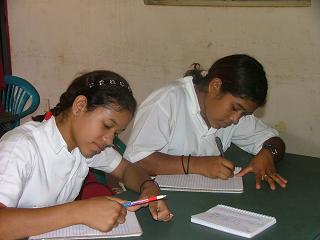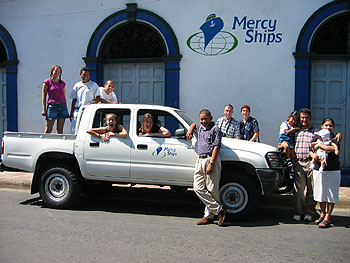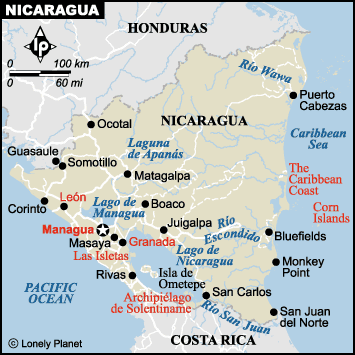This morning I wandered the streets of Leon on my own. I was in search of a tile shop in hopes that they sold decorative tile made in Central America (I love the old tile used in many of the buildings throughout Leon). The directions given me were off by a block or two and I was able to stop and ask for directions (dictionary in hand, of course) and understand and be understood. Feeling quite smug I ran into Lucrecia's niece at el parque a bit later and ended up holding a conversation neither of us could follow - oh well.
Beautiful ceiling tiles in the church down the street from the Mercy Ships Base

By the way, the tile shop was a bust. They were selling tile that could be picked up at any Home Depot.
After leaving Lucrecia's niece, I headed over to the mercado. Once again I was accosted by vedors trying to drag me into their stalls, but I emerged unscathed. I did end up in what I called the meat mall. It is the section of the mercado where the meat vendors sell. I must say it was quite an experience. The smell was the first thing that hit me, not quite rotten, but on the edge. It was curious to see pig's feet and big sides of beef out in the open; not refrigerated or carved by hair-netted, white-clothed butchers at all!
After fleeing the meat mall, I stoped and purchased a CocaCola Light (Diet Coke, which tastes like Diet Pepsi - bleh). Their sodas are mainly sold in glass bottles with the bottle reused again, and again, and again. I bought the soda and walked off towards the Mercy Ships base drinking down my Coke. When I arrived, Michelle told me that I bought the drink, not the bottle and I needed to return it to the vendor! So off I went trudging back to the mercado and trying to locate the vendor I bought the soda from. Finally locating her, I nonchalantly walked up to the booth and handed her the bottle with a big "Gracias Senorita" like I planned it this way all along.
After a fabulous noon meal at Mercy Ships by Veronica, a Nicaraguan hired by the base to cook for them, and the English class with the girls, I set out with Maria (a long-term staffer from New York) to go shopping. We tried several shops for Nicaraguan t-shirts, but none were to be found. Ironically, I found Sacramento Kings and LA Lakers basketball jerseys, but no touristy tees.
We ended up back at the Parque Central (Central Park), which is in front of the Catedral of Leon and actually found a little shack with Nicaraguan-made items (but no t-shirts). In the actual park, there was a sidewalk vendor with touristy tees for sale (finally!) so I was able to score a couple for my kids.
Walking the streets of Leon is always an adventure. Pedestrians do not have the right of way and must watch out for vehicle and bicyclists. The cars especially like to weave in and out of traffic and buses bear down with horns blaring. Thank goodness most of the streets are one-way (however, I have no idea how they determine which way to go; there are no signs).
This evening Mike and Maria (long-term volunteers from New York), my mother and I went out to dinner at a taco vendor known to Mike and Maria. We decided to take the city bus in deference to my mother's walking ability (she's 79 after all!). The journey was a bit like "Mr. Toad's Wild Ride," as the bus bucked and jerked screaming down the streets with the passengers hanging on for dear life. I must say, I have been very impressed with the males here in Nicaragua. Every time I have ridden public transportation, I have observed that the men have always given up their seats to the women - this has not happend to me in the USA for years! Once again the bus driver, as with the camioneta, has a symbiotic relationship with the conductor or corbrador (collector) as I later found out they were called. The Corbrador lets the driver know when he can proceed and helps passengers on and off the bus in addition to collecting fares and making change.
The taco stand was nearby the Catholic school, which was hosting an evening activity for the school-age kids. The play-yard (the size of a soccer field) was filled with hundreds of kids with a sound system blaring Nicaraguan rap music (very interesting, I must get the CD). The kids were playing basketball, volleyball, soccer, dancing or hanging out along the edges of the yard. I even spied some teen-agery types making out in the shadows (aw, I remember the days...).
The tacos ended up looking and tasting more like what we call taquitos (found in the frozen food section at Costco). They were amazing, served with a delicious cabbage salad with a sour cream dressing. This time, the vendor poured my soda into a plastic baggie with a straw poking out the top and kept the bottle (word must have spread through Leon about the crazy American who takes the soda bottles - heehee).
We chose to take a taxi back to the base eventhough I was kind of looking forward to another wild ride on the bus.
Good night all! Tomorrow - the beach!
 . You can read about our trip in the posts below. (For some reason when I recently republished my posts, the photos did not appear - at some point I will need to upload them again - sorry!)
. You can read about our trip in the posts below. (For some reason when I recently republished my posts, the photos did not appear - at some point I will need to upload them again - sorry!)


